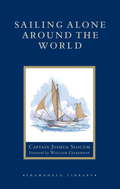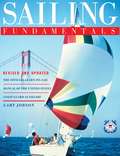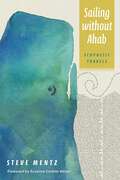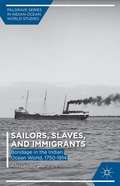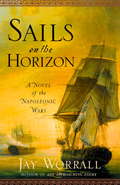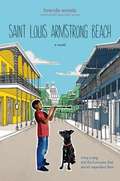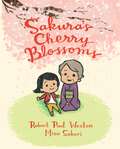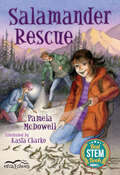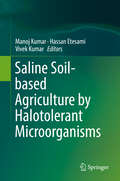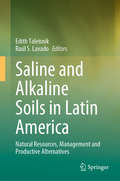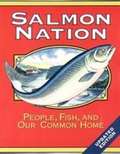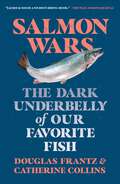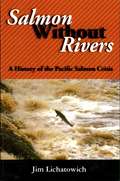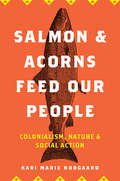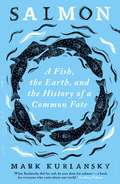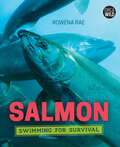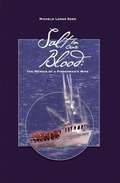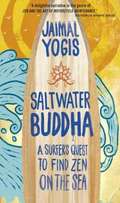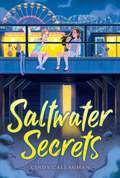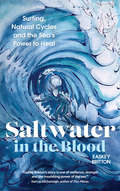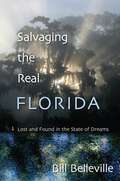- Table View
- List View
Sailing Alone around the World
by Joshua Slocum William GilkersonFull of astounding adventures, Sailing Alone around the World is the true story of the first man ever to circle the globe alone entirely by sea. In a little over three years, Captain Joshua Slocum completed the feat many experts believed couldn't be done--and he has the stories to prove it. During his historic voyage, Slocum was chased by pirates in Gibraltar, soaked by a "rain of blood" in Australia, and battered by perilous storms in the open ocean. He also met many famous--and infamous--people along the way, from Mrs. Robert Louis Stevenson in Samoa, to Black Pedro, "the worst murderer in Tierra del Fuego." This absorbing tale, written with humor and poetic eloquence, was first published in 1900 and has remained in print ever since.
Sailing Escape to Guam
by Bill BeckerSailing ESCAPE to Guam, is a story about a fictitious family of five in a sailboat named "ESCAPE" from California to Guam. They stopped at Hawaii, Marshall Islands, Ponape along the way. They were headed for Guam, when dramatic things happen to the family. Brian, the husband, father and captain is rendered comatose by an accident, some 300 miles east of Guam. His wife, Sharon, who was proficient in domestic duties, didn't have a clue about sailing the boat. Alan, the oldest son, to whom the captaincy of ESCAPE should have fallen, was possessed with a changing hormone mix that interfered with his rational thinking. Steve, the twelve-year-old son and his eleven-year-old sister, Kelly, were determined to sail the boat to a harbor in Guam or at least close enough to land to get help for their ailing father. A maturing process takes place as the children meet each of the challenges presented to them. Though they endured many hardships and surprises, the two young children remained determined to succeed.
Sailing Fundamentals
by Gary JobsonWritten by America's foremost instructional authority, the new edition of Sailing Fundamentals combines the training programs of the American Sailing Association and the United States Coast Guard Auxiliary. The official learn-to-sail manual of the American Sailing Association, it is also used in the programs of many yacht clubs, colleges, and sailing groups. Unlike most introductory sailing books, which reflect the biases and idiosyncrasies of their authors, Sailing Fundamentals has been extensively pretested by ASA professional instructors to ensure that it offers the fastest, easiest, most systematic way to learn basic sailing and basic coastal cruising. This book covers every aspect of beginning sailing -- from hoisting sail to docking and anchoring -- and specifically prepares the learner to qualify for sailing certification according to international standards. Widely acclaimed author Gary Jobson has won several major races, including the 1977 America's Cup victory as tactician aboard Courageous. He was head sailing coach at the U.S. Naval Academy, and has conducted sailing clinics across the country. Illustrated step-by-step in two colors with over 150 line drawings and photographs.
Sailing without Ahab: Ecopoetic Travels
by Steve MentzJourney through uncharted literary waters and explore Melville’s epic in bold new lightCome sail with I.We’re not taking the same trip, though you might recognize the familiar course. This time, the Pequod’s American voyage steers its course across the curvature of the Word Ocean without anyone at the helm. We are leaving one man and his madness on shore. Our ship overflows with glorious plurality—multiracial, visionary, queer, conflicted, polyphonic, playful, violent. But on this voyage something is different. Today we sail headless without any Captain. Instead of binding ourselves to the dismasted tyrant’s rage, the ship’s crew seeks only what we will find: currents teeming with life, a blue-watered alien globe, toothy cetacean smiles from vasty deeps. Treasures await those who sail without.This cycle of one hundred thirty-eight poems—one for each chapter in Moby-Dick, plus the Etymology, Extracts, and Epilogue—launches into oceanic chaos without the stabilizing mad focus of the Nantucket captain. Guided by waywardness and curiosity, these poems seek an alien ecopoetics of marine depths, the refraction of light, the taste of salt on skin. Directionless, these poems reach out to touch oceanic expanse and depth. It’s not an easy voyage, and not a certain one. It lures you forward. It has fixed its barbed hook in I.Sailing without means relinquishing goals, sleeping at the masthead, forgetting obsessions. I welcome you to trace wayward ways through these poems. Read them any way you can—back to front, at random, sideways, following the obscure promptings of your heart. It’s the turning that matters. It’s a blue wonder world that beckons.
Sailors, Slaves, and Immigrants
by Alessandro StanzianiSlaves, convicts, indentured immigrants, and unfree seamen have traveled the world's oceans at many times and places throughout human history. Across the Atlantic, Mediterranean, Indian, and Pacific Oceans, this bondage took divergent forms and exhibited a range of historical dynamics. In spite of this variety, the conventional Atlantic World historical paradigm has largely shaped our understanding of modernity as being defined by exploration and discovery, European dominance, global capitalism, and the transition from slavery to free labor. Not only does this perspective evince a Eurocentric emphasis on the 'uniqueness' of the West, but it is increasingly contested even for the Atlantic itself. This provocative study contrasts the romantic conflation of freedom and the sea with the complex labor relationships of seamen, slaves, and immigrants in the Indian Ocean during the long nineteenth century. In the process, it advances a new framework for understanding labor, bondage, and modernization.
Sails on the Horizon: A Novel of the Napoleonic Wars
by Jay WorrallThe year is 1797. Napoleon Bonaparte is racking up impressive wins in the field against the enemies of revolutionary France, while on the seas England is putting up a staunch resistance. Twenty-five-year-old Charles Edgemont is second lieutenant aboard the British ship Argonaut. When orders come for the Argonaut to engage in an all-but-suicidal maneuver to prevent the escape of Spanish ships off the coast of Portugal, he leads his gun crews bravely-until the deaths of the captain and first lieutenant elevate him to commander. For refusing to yield to enemy fire, Charles is permanently promoted and generously rewarded by the Admiralty, becoming wealthy beyond his wildest dreams. Yet upon his return home, his newfound riches prove no help when it comes to winning the heart of Penelope Brown, who regards war as sinful and soldiers as little better than murderers. Changing Penelope's mind may just be the hardest battle Charles has ever fought-at least until fresh orders send him back to sea, where hefaces a formidable adversary in a series of stirring battles of will and might.
Saint Louis Armstrong Beach
by Brenda WoodsThe gripping story of a boy, a dog and a hurricaneSaint is a boy with confidence as big as his name is long. A budding musician, he earns money playing clarinet for the New Orleans tourists. His best friend is a stray dog named Shadow, and it's because of Shadow that Saint's still in town when Hurricane Katrina hits. Saint's not worried about the hurricane at first--he plans to live to be a hundred just to defy his palm-reader friend Jupi, who told him he had a short life line. But now the city has been ordered to evacuate and Saint won't leave without Shadow. His search brings him to his elderly neighbor's home and the three of them flee to her attic when the waters rise. But when Miz Moran's medication runs out, it's up to Saint to save her life--and his beloved Shadow's. .
Sakura's Cherry Blossoms
by Robert Paul WestonA warm, gorgeous exploration of a little girl's experience immigrating to a new country and missing her home and her grandmother, who still lives far away.Sakura's dad gets a new job in America, so she and her parents make the move from their home in Japan. When she arrives in the States, most of all she misses her grandmother and the cherry blossom trees, under which she and her grandmother used to play and picnic. She wonders how she'll ever feel at home in this new place, with its unfamiliar language and landscape. One day, she meets her neighbor, a boy named Luke, and begins to feel a little more settled. When her grandmother becomes ill, though, her family takes a trip back to Japan. Sakura is sad when she returns to the States and once again reflects on all she misses. Luke does his best to cheer her up -- and tells her about a surprise he knows she'll love, but she'll have to wait till spring. In the meantime, Sakura and Luke's friendship blooms and finally, when spring comes, Luke takes her to see the cherry blossom trees flowering right there in her new neighborhood.Sakura's Cherry Blossoms captures the beauty of the healing power of friendship through Weston's Japanese poetry-inspired text and Saburi's breathtaking illustrations.
Salamander Rescue (Orca Echoes)
by Pamela McDowellCricket McKay is back and answering a new SOS: "Save Our Salamanders!" Cricket McKay has lived in Waterton all her life, so she is surprised to discover an animal she hasn’t seen before: the long-toed salamander. She finds a band of them migrating from the pond to their hibernation grounds at Crandell Mountain. Crossing the road that lies between the pond and the mountain is dangerous enough, but now a newly-constructed curb makes their journey even more challenging. Can Cricket and her friends come up with a solution to help the salamanders? Salamander Rescue is the second book featuring Cricket and friends. The epub edition of this title is fully accessible.
Salamander Song
by Ginny NeilA spring refrain! A salamander rain! This lush, lyrical story illuminates the convergence of wildlife and citizen science--and the big impact young readers can have on vulnerable species. Salamanders and children alike hear the rhythms and song of the seasons as winter gives way to spring. Salamanders begin to squirm and stretch in the early spring sun, while the children and their teacher plan. They meet on a night of salamander rain (the first warm rain of spring), when the children and their teacher work to help the salamanders cross a busy road to the vernal pool on the other side. This lyrical, parallel narrative story reinforces the idea that kids can make a big difference. The author's note includes information about amphibian migrations and descriptions of citizen science activities that kids can participate in to help keep the world wild and beautiful.
Saline Soil-based Agriculture by Halotolerant Microorganisms
by Manoj Kumar Vivek Kumar Hassan EtesamiThis book discusses the role of salt in current agricultural approaches, including the low salt tolerance of agricultural crops and trees, impact of saline soils, and salt-resistant plants. Halophytes are extremely salt tolerant plants, which are able to grow and survive under salt at concentrations as high as 5 g/l by maintaining negative water potential. The salt-tolerant microbes inhabiting the rhizospheres of halophytes may contribute to their salt tolerance, and the rhizospheres of halophytic plants provide an ideal opportunity for isolating various groups of salt-tolerant microbes that could enhance the growth of different crops under salinity stress. The book offers an overview of salt-tolerant microbes' ability to increase plant tolerance to salt to facilitate plant growth, the potential of the halophytes’ rhizospheres as a reservoir of beneficial salt-tolerant microbes, their future application as bio-inoculants in agriculture and a valuable resource for an alternative way of improving crop tolerance to salinity and promoting saline soil-based agriculture. This special collection of reviews highlights some of the recent advances in applied aspects of plant (halophytes)-microbe interactions and their contribution towards eco-friendly approaches saline soil-based agriculture.
Saline and Alkaline Soils in Latin America: Natural Resources, Management and Productive Alternatives
by Edith Taleisnik Raúl S. LavadoThis book provides the first comprehensive overview of saline and alkaline soils in Latin America, known for having one of the most extensive surface of salt-affected soils in the world. It is organized along two main axes: soils and vegetation. The book discusses the occurrence of such soils in the region, focusing mainly in management strategies for their sustainable use, and it presents accounts of natural vegetation and crops in the various environments of the region. Social impacts of such conditions and ongoing projects to overcome them are considered. Likewise, the book highlights physiological mechanisms that are responsible for the negative effects these soils exert on crops and forest resources and determine vegetation distribution in them. Plant breeding challenges and new perspectives for such environments are discussed. Technologies such as irrigation and drainage are included. The readership includes soil and plant scientists, as well as policy makers.
Salmon (WorldLife Library)
by John M. BaxterThe life cycle of the salmon is a remarkable story of survival. Their amazing feat of migration from freshwater streams to saltwater oceans and back again is one of the great wonders and mysteries of the natural world. In this authoritative book, John Baxter uncovers the origins, migratory instincts, and life histories of the seven salmon species found around the world: Atlantic, chinook, coho, sockeye, masu, pink, and chum. He also explores the many conservation issues facing salmon today, which are declining because of pollution, overfishing, and changes to river habitats.
Salmon Nation: People, Fish, and Our Common Home
by Elizabeth Woody Edward Wolf Seth ZuckermanSalmon Nation takes general readers behind the headlines int the company of six knowledgeable guides to a deeper understanding of the most celebrated fish of western North America. Thoughtful essays by Native American writer Elizabeth Woody, fisheries biologist Jim Uchatowich, journalist Richard Manning, former commercial fisherman Freeman House, and writer Seth Zuckerman trace the relationship between people and salmon from the days of abundance that sustained Northwest Coast native cultures to the troubled world of salmon today. Geographer Dorie Brownell's full-color maps offer a powerful big picture perspective that lends new urgency to efforts to heal the breach between people and salmon.
Salmon Wars: The Dark Underbelly of Our Favorite Fish
by Douglas Frantz Catherine CollinsA Pulitzer Prize-winning correspondent and a former private investigator dive deep into the murky waters of the international salmon farming industry, exposing the unappetizing truth about a fish that is not as good for you as you have been told.A decade ago, farmed Atlantic salmon replaced tuna as the most popular fish on North America’s dinner tables. We are told salmon is healthy and environmentally friendly. The reality is disturbingly different.In Salmon Wars, investigative journalists Douglas Frantz and Catherine Collins bring readers to massive ocean feedlots where millions of salmon are crammed into parasite-plagued cages and fed a chemical-laced diet. The authors reveal the conditions inside hatcheries, where young salmon are treated like garbage, and at the farms that threaten our fragile coasts. They draw colorful portraits of characters, such as the big salmon farmer who poisoned his own backyard, the fly-fishing activist who risked everything to ban salmon farms in Puget Sound, and the American researcher driven out of Norway for raising the alarm about dangerous contaminants in the fish. Frantz and Collins document how the industrialization of Atlantic salmon threatens this keystone species, endangers our health and environment, and lines the pockets of our generation's version of Big Tobacco. And they show how it doesn't need to be this way.Just as Eric Schlosser’s Fast Food Nation forced a reckoning with the Big Mac, the vivid stories, scientific research, and high-stakes finance at the heart of Salmon Wars will inspire readers to make choices that protect our health and our planet.
Salmon Without Rivers: A History Of The Pacific Salmon Crisis
by James A. LichatowichFrom a mountain top where an eagle carries a salmon carcass to feed its young to the oceanic waters of the California current and the Alaskan Gyre, salmon have penetrated the Northwest to an extent unmatched by other animals. Since the turn of the twentieth century, natural productivity of salmon in Oregon, Washington, California, and Idaho has declined 80 percent. The decline of Pacific salmon to the brink of extinction is a sign of serious problems in the region.In Salmon Without Rivers, fisheries biologist Jim Lichatowich offers an eye-opening look at the roots and evolution of the salmon crisis in the Pacific Northwest. He describes the multitude of factors over the past century and a half that have led to the salmon's decline, and examines the failure of restoration efforts that have focused almost exclusively on hatcheries to return salmon stocks to healthy levels without addressing underlying causes of the decline.Lichatowich argues that the dominant worldview of our society -- a worldview that denies connections between humans and the natural world -- has created the conflict that characterizes the recent history of salmon; unless that worldview is challenged, there is little hope for recovery. Salmon Without Rivers exposes the myths that have guided recent human-salmon interactions. It explains the difficult choices facing citizens of the region, and provides unique insight into one of the most tragic chapters in our nation's environmental history.
Salmon and Acorns Feed Our People: Colonialism, Nature, and Social Action (Nature, Society, and Culture)
by Kari Marie NorgaardSince time before memory, large numbers of salmon have made their way up and down the Klamath River. Indigenous management enabled the ecological abundance that formed the basis of capitalist wealth across North America. These activities on the landscape continue today, although they are often the site of intense political struggle. Not only has the magnitude of Native American genocide been of remarkable little sociological focus, the fact that this genocide has been coupled with a reorganization of the natural world represents a substantial theoretical void. Whereas much attention has (rightfully) focused on the structuring of capitalism, racism and patriarchy, few sociologists have attended to the ongoing process of North American colonialism. Salmon and Acorns Feed Our People draws upon nearly two decades of examples and insight from Karuk experiences on the Klamath River to illustrate how the ecological dynamics of settler-colonialism are essential for theorizing gender, race and social power today.
Salmon: A Fish, the Earth, and the History of a Common Fate
by Mark KurlanskyMost of what we do on land ends up impacting the ocean, but never is that clearer than when we look at salmon. Centuries of our greatest assaults on nature, from overfishing to dams, from hatcheries to fish farms, from industrial pollution to the ravages of climate change, can be seen in their harrowing yet awe-inspiring life cycle. From the Pacific to the Atlantic, through Scotland, Ireland, Norway, Iceland, Japan and Siberia, Mark Kurlansky traces the history of the world through his fish-eye lens, laying bare our misdirected attempts to manipulate salmon for our own benefit. Attempts that have had a devastating impact on both fish and earth. Now, the only way to save salmon is to save the planet, and the only way to save the planet may be to save the salmon.
Salmon: Swimming for Survival (Orca Wild #8)
by Rowena RaeSalmon: Swimming for Survival introduces us to the dramatic life story of salmon. These fish hatch in streams, swim extreme distances out to sea, and then migrate home to where they were born to produce the next generation. But today their habitats and very survival are threatened by human activity. This book looks at the unique biology of salmon, their importance to many Indigenous communities, their cultural and economic impact and the vital role they play in ecosystems. With profiles from scientists, educators, fishers and more, learn about the people who are working hard to change the uncertain future of salmon and improve the chance that these iconic fish can survive for generations to come.
Salt in Our Blood: The Memoir of a Fisherman's Wife
by Michele Longo EderIn 2000, Michele Longo Eder began a journal to record what daily life was like for her while her husband and sons were out commercial fishing off the coasts of Oregon, Washington, and northern California. But personal tragedy struck just before Christmas 2001. This book is an offer of healing to her family, her community, and to fishing families everywhere.
Saltwater Buddha: A Surfer's Quest to Find Zen on the Sea
by Jaimal YogisFed up with his suburban teenage life, at age sixteen, Jaimal Yogis ran off to Hawaii with little more than a copy of Hermann Hesse's Siddhartha and enough cash for a surfboard.
Saltwater Secrets
by Cindy CallaghanFrom the acclaimed author of Just Add Magic—now a hit streaming original series—comes a sweet novel about two sisters on summer vacation that explores the intricate bonds of a blended family.Stella and Josie live for their summers at the boardwalk—each one a carbon copy of the last. Josie lives in Australia most of the year; her half-sister, Stella, lives in New Jersey. But every year, they come together for a beach vacation with their dad, and to make more memories. The real excitement for them is their secret special place under the boardwalk, where they hide their sister scrapbook, adding memories from each summer. But this summer feels different. Josie isn&’t the same—she&’s turned into one of the popular girls that Stella can&’t stand. Despite the rocky start to their vacation, they still go to their secret, special place under the boardwalk, adding memories to their sister scrapbook once again. That is, until that place is discovered by the owners of the newest store—the Smoothie Factory, which replaced Josie&’s favorite sweet spot. Not only have the owners of the Smoothie Factory discovered the cove, they are exploiting the natural habitat, and endangering marine life and everyone at the beach! It&’s up to Josie and Stella to figure out how to stop their beloved boardwalk from disappearing for good.
Saltwater in the Blood: Surfing, Natural Cycles and the Sea's Power to Heal
by Easkey BrittonPowerful feminist nature writing by the pioneer of women's big-wave surfing in Ireland. Easkey Britton provides a rare female perspective on surfing, exploring the mental skills it fosters, and the need to recognize the value of the ocean and of nature's cycles in our lives.This is an incredibly inspiring exploration of the sea's role in the wellness of people and the planet, beautifully written by Easkey Britton – surfer, scientist and social activist. She offers a powerful female perspective on the sea and surfing, explaining what it&’s like to be a woman in a man's world and how she promoted the sport to women in Iran, surfing while wearing a hijab. She speaks of the undiscussed taboo around entering the water while menstruating – and of how she has come to celebrate her own bodily cycles. She has developed her own approach to surfing, which instead of seeking to dominate the waves, works in tune with the natural cycles of her body, the moon and the seasons. In a society that rewards busyness, she believes that understanding the influence of cycles becomes even more important – and we all have them, men and women. For Easkey, the sea is a source of mental and physical wellbeing. She explores the mental toughness needed in big-wave surfing, and presents surfing as an embodied mindfulness practice in which we can find flow and connect with the movement of the waves. She stresses the need to recognize the ocean as our most powerful ally when addressing our greatest global challenge: the climate crisis. Above all, Easkey&’s relationship to the sea has taught her about the need to meet life and evolve with it, rather than seeking to control it. By such wisdom our planet might just survive and thrive.
Salute
by C. W. AndersonFrom the Book jacket: "If I only knew someone who would give him a good home." The owner of a fine horse, just crippled on the track, made the remark and Peter overheard him. Peter was ten and his father had taken him to his first race at Saratoga. He had always loved horses-Mohawk's owner could tell that from the way he acted. Could he take the horse? His father said he could, so a few days later Mohawk came home. Happy, busy days followed for both Peter and Mohawk, for no horse ever received more tender care. He grew strong and lively too. And when another year came around, he ran again and won $500. Perhaps you can guess what Peter did with his money. ... He bought a yearling, and, most exciting of all, Salute was a grandson of the great Man o' War. The artist's beautiful lithographs were all drawn directly on the zinc plates, a technique which gives them a rich depth in tone and quality. C. W. ANDERSON "Young horse lovers are extremely fond of C. W. Anderson's books. They have handsome horse portraits, and they tell in simple, straightforward fashion of the experience of children with horses." -New York Herald Tribune C. W. Anderson grew up in Wahoo, Nebraska, and studied at the Art Institute of Chicago. His first book, Billy and Blaze, was published by Macmillan in 1936. Since then more than half a million Billy and Blaze Books have been sold, and Mr. Anderson has come to be recognized as America's foremost author- illustrator of horse stories. He has written such favorites for young readers as A Filly for Joan and High Courage, as well as books for horse enthusiasts of all ages such as Heads Up, Heels Down, C. W. Anderson's Complete Book of Horses and Horsemanship, and Twenty Gallant Horses. Horses still dominate Mr. Anderson's life as an artist and sportsman. He has a country home in Mason, New Hampshire, where he rides, and a studio in Boston.
Salvaging the Real Florida: Lost and Found in the State of Dreams
by Bill BellevilleModern life has a tendency to trap people in cubicles, cars, and cookie-cutter suburbs. Thankfully, someone comes along now and then to remind us of the beauty that presents itself when we turn off the information feeds and turn away from the daily grind. Bill Belleville’s enchanting Salvaging the Real Florida invites readers to rediscover treasures hidden in plain sight. Join Belleville as he paddles a glowing lagoon, slogs through a swamp, explores a spring cave, dives a "literary" shipwreck, and pays a visit to the colorful historic district of an old riverboat town. Journey with him in search of the apple snail, the black bear, a rare cave-dwelling shrimp, and more. Everywhere he goes, Belleville finds beauty, intrigue, and, more often than not, a legacy in peril. Following in the tradition of John Muir, William Bartram, and Henry David Thoreau, Belleville forges intimate connections with his surroundings. Like the works of Marjory Stoneman Douglas and Archie Carr, his evocative stories carry an urgent and important call to preserve what is left of the natural world.
